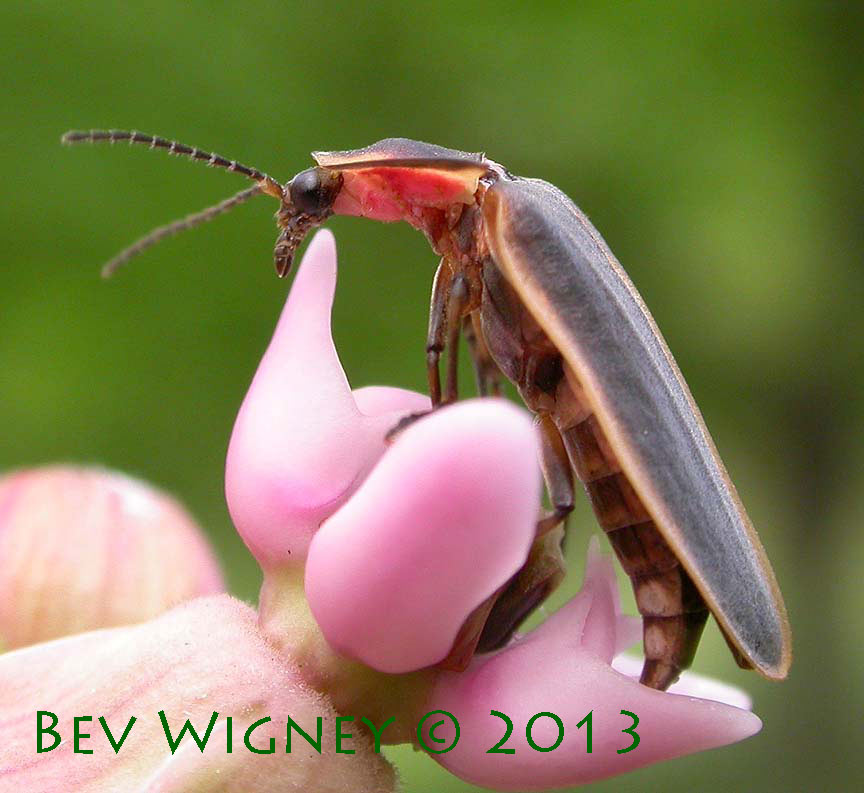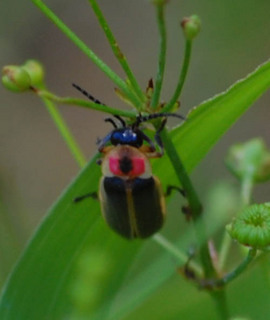Nutrition
 In
general, fireflies are considered omnivores. When it comes to a firefly’s
dietary needs, it differs depending on the adult males, adult females, and
the larvae. Male adult fireflies typically do not eat at all
(Swan & Papp, 1972). This is because their main purpose is to mate.
However, some males do choose to feed on nectar or even pollen from flowers.
Female fireflies, on the other hand, are known to be mostly predacious. Some
females actually consume other, more minute insects as well as the male
fireflies. In fact, these predacious females flash other species’ mating
signals out into the night (Marshall, 2006).
Males recognize these signals and seek to mate with the female. After the
male is lured in by the female, she makes him a fresh meal. To learn more
about this, visit the adaption page. The larvae
of fireflies have quite a different meal plan than the adults.
In
general, fireflies are considered omnivores. When it comes to a firefly’s
dietary needs, it differs depending on the adult males, adult females, and
the larvae. Male adult fireflies typically do not eat at all
(Swan & Papp, 1972). This is because their main purpose is to mate.
However, some males do choose to feed on nectar or even pollen from flowers.
Female fireflies, on the other hand, are known to be mostly predacious. Some
females actually consume other, more minute insects as well as the male
fireflies. In fact, these predacious females flash other species’ mating
signals out into the night (Marshall, 2006).
Males recognize these signals and seek to mate with the female. After the
male is lured in by the female, she makes him a fresh meal. To learn more
about this, visit the adaption page. The larvae
of fireflies have quite a different meal plan than the adults.
Firefly larvae are also predacious, just like most female
adults. They are carnivorous larvae that consume other organisms, such as
terrestrial gastropods, like slugs and snails. Larvae diet also includes
earthworms and other insect larvae (Rios & Quinta,
2010). Slugs, snails, and earthworms are commonly found in leaf litter,
which is where firefly larvae travel to reach them. A majority of the time,
larvae appear on the surface of the ground/soil only to search for prey.
Otherwise, they spend their larval stage underground, where they can find
another food source of other insect larvae. Like the adults, larvae are also
nocturnal; therefore, they hunt for their prey at night (Ballantyne, 1987). Once the
firefly larvae locate a food source, they wrap themselves around their prey,
and inject a paralyzing toxin secreted in their mouths. After this toxin
enters the organism’s body, it paralyzes them almost instantly
(Swan & Papp, 1972).
prey at night (Ballantyne, 1987). Once the
firefly larvae locate a food source, they wrap themselves around their prey,
and inject a paralyzing toxin secreted in their mouths. After this toxin
enters the organism’s body, it paralyzes them almost instantly
(Swan & Papp, 1972).
When food is consumed by fireflies, it is broken down by their digestive system and the nutrients are absorbed. Photinus pyralis is classified under the phyla Antropdoda and these organisms have an open circulatory system. When an organism, like the firefly, has an open circulatory system, it means they do not contain a system of veins. Instead, the blood (hemolymph) moves freely throughout the body cavity without veins (Rios & Quinta, 2010). This type of circulatory system allows the food consumed to be transported to the various body parts. All of these concepts aid in digestion of food for firefly adults and larvae.